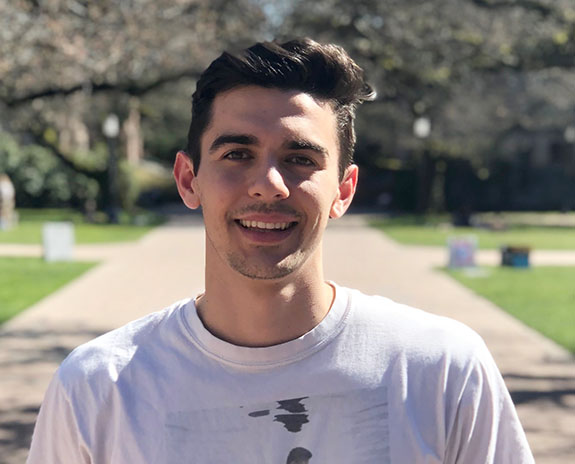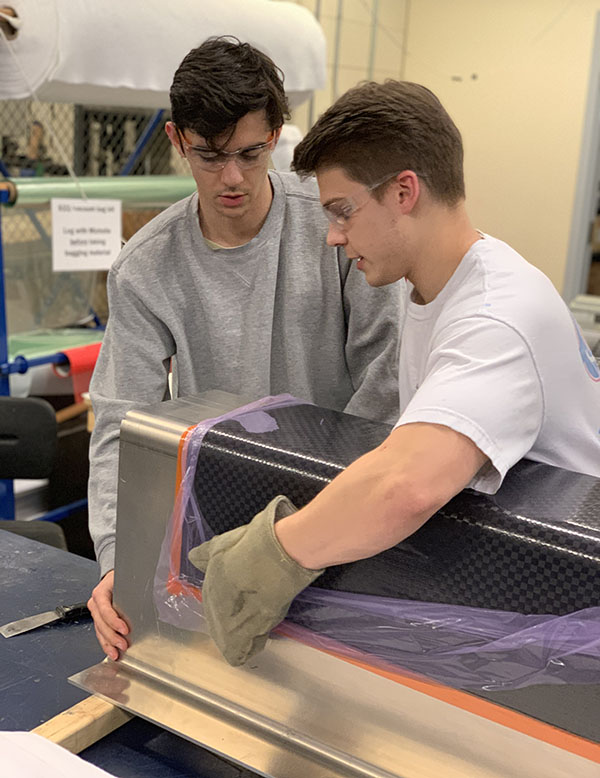Amy Sprague
March 21, 2019
John’s positive attitude and eagerness to learn drove the success of his projects here, many of which just splashed down with our recent Demo-1 mission. – Ryan Schroeder, SpaceX

John Buffalo wins a second Mary Gates Scholarship.
After a six-month leave of absence from the University of Washington to work at SpaceX, John Buffalo has returned to win a second $5,000 Mary Gates Research Scholarship to advance his composites research under A&A’s Multiscale Analysis of Materials and Structures Lab (MAMS Lab) and the mentorship of A&A Professor Marco Salviato.
The Mechanical Engineering junior’s work will serve his two high-profile projects: the SpaceX Dragon 2 crew capsule and the award-winning UW Hyperloop Team. Buffalo comments, “It’s amazing to me how these two projects are so interconnected by the research.”
During Buffalo’s leave of absence to intern at SpaceX’s Hawthorne, California, headquarters, he was working on the Dragon 2 capsule’s exterior thermal composite backshell for the recent uncrewed demonstration test mission 1 which reached the international space station. He then transitioned to work on the full production of the parachute door and its sub-assemblies for re-entry for the crewed demonstration test mission 2 scheduled for this July.
He is also the structures lead for the UW Hyperloop Team which placed #1 in the US and was awarded the design innovation award at last year’s SpaceX Hyperloop competition.
Both SpaceX and UW Hyperloop require the advanced composites research which Buffalo is developing as a research assistant in the MAMS Lab. The Mary Gates Research Scholarship is funding two main areas of this research, which will be incorporated into an upcoming design of the UW Hyperloop’s prototype, reported to SpaceX, and made available to wider audiences through conferences and publications.
The first area of research is an analysis of how composite materials fracture and absorb energy in a crash with the goal of building a computational model to demonstrate the UW Hyperloop’s crash safety capability using the constitutive theory developed in the MAMS Lab.
The second area of research targets the introduction of innovative curvilinear transversely isotropic materials into the UW Hyperloop prototype’s structural design. Says Buffalo, “Usually composites are made of fibers placed in straight lines. This project is especially interesting because we use additive manufacturing to lay conductive curvilinear paths on the material. We can then immediately monitor any emerging structural damage and cracks by measuring changes in the electric resistivity of the material as these paths are broken or distorted.”

Buffalo and fellow ME junior Brian Maiken working on the UW Hyperloop chassis.
He continues, “In particular, the MAMS Lab developed formulations for the curvilinear paths the conductive fibers must follow, so I’m working on building experimental data proving the theory behind the math works. Then, we will transfer the use of these composite materials to the UW Hyperloop prototype and publish an article on the theoretical and experimental results of this project.”
A&A alumnus Ryan Schroeder, Buffalo’s direct mentor and Dragon 2 manufacturing engineer at SpaceX said, “John has a demonstrated ‘get it done’ attitude that we value here at SpaceX, which is evident in his contributions to the UW Hyperloop Team. SpaceX shares an interest in John’s vital composites research, and we are eager to see the results of these next rounds of testing and validation. On a personal note, John’s positive attitude and eagerness to learn drove the success of his projects here, many of which just splashed down with our recent Demo-1 mission.”
The published research will not only inform UW Hyperloop and SpaceX’s capsules, but will serve to advance the state of the art in crash safety, durability, and damage monitoring in future earth and space vehicles. Ultimately, Buffalo will be extending this year’s research toward the development and production of next-generation spacecraft structures enabling space travel to anywhere in the Solar System.
Salviato summed up Buffalo and his work, "While it is a great accomplishment to win not only one, but two Mary Gates Scholarships, I was not at all surprised to hear of John's second award. I was impressed with John from the first minute I spoke to him. It was like talking to a peer, not an undergraduate.”
He continued, ”I consider myself extremely lucky that he has joined our lab. He is eager to learn and contribute to our theories and models and then seeks the additional knowledge and resources needed to start testing these models in the real world. As an example, he has taken the theories we have developed in the lab to achieve a reduction in the weight of the primary Hyperloop pod structures from 60 pounds to 18 pounds. John's capacity to bring theory into practice is unrivaled, and I look forward to seeing where he goes with his career."